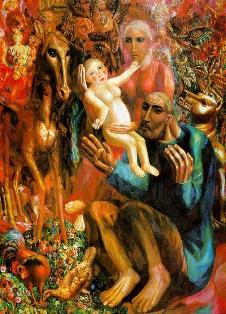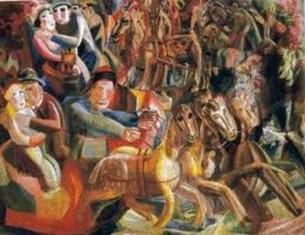Filonov Pavel Nikolaevich - an outstanding Russian painter, graphic artist, poet, art theorist. Born in a poor family in Moscow in 1883. From childhood, he had to face difficulties and hardships. Orphaned early, he made his living by retouching photographs, embroidering tablecloths and napkins, painting posters and packaging for goods. The boy’s talent for drawing appeared at the age of three to four years.

In 1897 he moved to Petersburg, where he began to take painting lessons. In 1908, at the age of 25, Filonov entered the St. Petersburg Academy of Arts, but in 1910 he was expelled from it, because he risked rebelling against the dictatorship of the academy professors, who imposed classical standards on their students. Since that time, he tried to establish himself as an independent artist, intolerant of generally accepted aesthetic traditions. In truth, Pavel Filonov opposed both classical realism and the vanguard of the turn of the century, namely Cubism and Futurism. Resentful of the geometric and mechanical principles of such art, he believed that representatives of these directions interpret nature too simply, focusing on only two of its aspects: color and shape.
Being virtually self-taught, a man of considerable intellectual abilities, the artist never sold his paintings and did not write anything to order. Pavel Filonov took private drawing lessons from Lev Evgrafovich Dmitriev-Kavkazsky, a copper engraver, etcher and draftsman, visiting his Workshop for Students. In 1911, the artist went on a pilgrimage. For six months, he hikes across Russia, the Middle East, Italy and France. To pay for food and shelter, he painted walls in those houses where he found shelter.
During the First World War, Pavel Filonov
He fought on the Romanian front. Unconditionally accepted the
October Revolution, was elected chairman of the Executive Council of the Danube region. Returning to Petrograd, he founded a painting studio in which he created the scenery for a number of theatrical performances, illustrations for the Finnish epos Kalevala.
Two works, written in 1910, anticipated the development of the analytical method of the artist. This is the "Peasant Family" and "Heads", because of which Pavel Filonov was expelled from the Academy. Contemporaries did not understand them.
"World Flourish" is the name given by the artist to his own system of analytical art, which is the result of cubo-futuristic experiments undertaken by him in 1913-1915. It is characterized by a very detailed and multifaceted method - a picture is created from a point to a general image (“like a germinating grain”) with the thinnest of brushes and a sharp pencil on a relatively flat surface. Images have multiple points of view (as in Cubism), but are based on the principle of simultaneity, characteristic of futurism. The artist’s philosophy was set forth in the work “Flowers of World Prosperity” in 1915. Then it was revised and published in the form of a “Declaration” in 1923, when Pavel Nikolayevich Filonov was appointed teacher at the Petrograd Academy of Arts. "The ideology of analytical art" was published in 1930.

Despite the fact that his incredible talent was recognized in the 1920s, the artist later does not find understanding among critics. His exposition in the Russian Museum was actually banned, and students and friends left him. Mikhail Larionov and Natalya Goncharova emigrated, Velimir Khlebnikov died. He himself did not try to do anything to find any way out, because he was intolerant of any compromises. Refused to participate in exhibitions in Paris, Dresden, Venice, USA. Filonov wanted his works to be seen first at home, dreamed of creating a museum of analytical art. Three times he rejected the offer to become a professor at the Academy of Arts, explaining his decision by fearing inconsistencies with his post. In the 1930s, the life situation changed for the worse. But despite the plight, he continued his creative search. However, hunger and cold prevailed. December 3, 1941, at the very beginning of the siege of Leningrad, Pavel Filonov was found dead in his apartment.